Split Squat Video
Introduction
I love split squats.
They’re like the more sensible version of squats. You know, a sophisticated, higher thinking type of exercise that knows what wine should be paired with dinner. They allow a lifter to still train legs, but without the same back stiffness afterwards.
They’re a more meatheaded lunge, too. Keeping the feet planted allows the lifter to keep tension on the muscle and pump some fatigue into their stilts.
In this article, I will outline what I like about split squats, how to do them correctly, and every mistake people tend to make when performing them incorrectly.
Why I Love the Split Squat
Balance
Split squats are an excellent way to challenge balance.
For someone with severe balance deficits, like with sarcopenia and stroke, they’re probably too challenging to do right away. Select them as a target and start working on it.
But after some training, the strength might be there to try split squats perhaps a wall to help for balance.
For the well-trained lifter, split squats serve as a way to train legs AND balance at the same time.
Reducing asymmetry
Split squats accentuate asymmetry. If a lifter discovers a shift in their hips when squatting, split squats are an excellent accessory exercise to add to the training program.
Due to the balance challenge and general complexity of the movement, there are a bunch of ways that split squats can be done WRONG. This is a good thing.
This gives the lifter actionable steps, things to fix. Take my checklist of errors later on in this article and just work through them.
Loading legs with less load on spine
Single leg training for hypertrophy was, in my mind, popularized by trainer Ben Bruno. Ben had trouble with back pain, but still wanted to lift heavy and train hard.
His solution was to throw away any preconceived notions about what heavy lifting should look like. He didn’t squat and deadlift simply because that’s what powerlifters did. He created his own solution.
A lifter can put tremendous load on the legs with these types of “single leg” exercises. Split squats are just the tip of the iceberg.
To achieve the same load on two legs, the lifter has to essentially double the weight lifted.
Hypertrophy
There are many ways to lift for size. It helps to do some heavy squats and deadlifts from time to time, but heavy split squats can still leave a lifter feeling crazy sore the next day. Just ask my clients as we work through this current program…
Athletic performance
The biggest issue with traditional squats for sport performance is that there aren’t many sports that allow for the kind of stability experienced in a barbell back squat.
Most sports move so fast that there simply isn’t time to pause, get set up correctly, and then push as hard as possible. Athletes need to demonstrate their power with a moment’s notice.
Hip mobility
This is probably too nerdy to share, but I’m going to anyway.
My actual favorite part about split squats is that they replicate the positions of our bones when walking.
Want to run faster? Maximize stride length and turnover. You need hip mobility for that.
Want to get out of pain? Even out the left and right steps.
Most hip mobility comes from the posture of the pelvic bones. For example, an anterior pelvic tilt steal hip mobility. The split squat gives the lifter asymmetrical movement to make the body more balanced.
How to Perform Split Squats
Finding your split squat stance
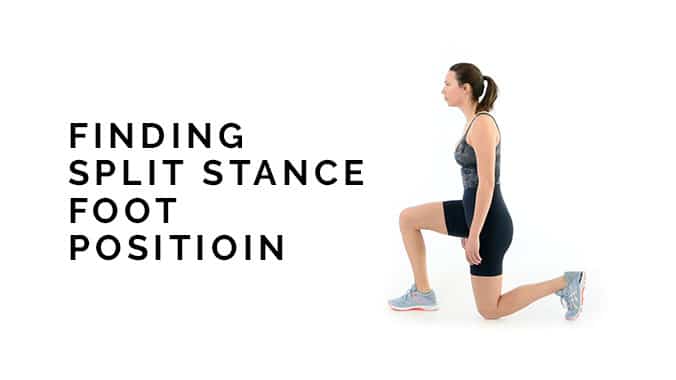
- Start in half kneeling; one knee on the ground, the other knee bent up and foot flat
- Shift the body until the center of mass is directly over the down knee
- Scoot the front foot until the front knee makes a roughly 90 degree angle
Stance is one of the few details that is not very important. It’s totally fine to be a little off of 90 degrees here. I like a slightly shorter stance because it helps me feel better leg drive. When opting for a longer stance, make sure to increase forward torso lean.
Executing the split squat
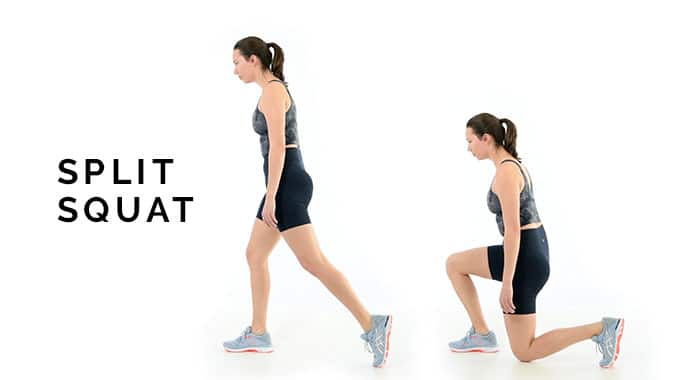
- Stand with one leg ahead of the other, the back heel off the ground, and a slight forward torso lean
- Keeping the front foot flat, squat down until the back knee lightly taps the ground
- Aim for a parallel torso and front shin at the bottom
- Return to standing
You should feel the split squat in the front leg’s glutes, hamstrings, and quads. The trailing quad is also involved and tends to burn more than any other muscle during this exercise.
Correct Split Squat Technique
Since split squats are a complicated movement, they are easy to perform incorrectly.
In a squat, the lifter has two feet firmly and broadly planted, allowing them to hide movement compensations. The split squat, however, exaggerates underlying asymmetries. And that’s why we love it.
In this section, we’ll outline all the ways a lifter might mess up the split squat.
Side view
Front view
- Front knee alignment
- Trailing knee alignment
- Hip sagging
- Hips not squared forward
- Asymmetrical rib flare
Pain
Back arched
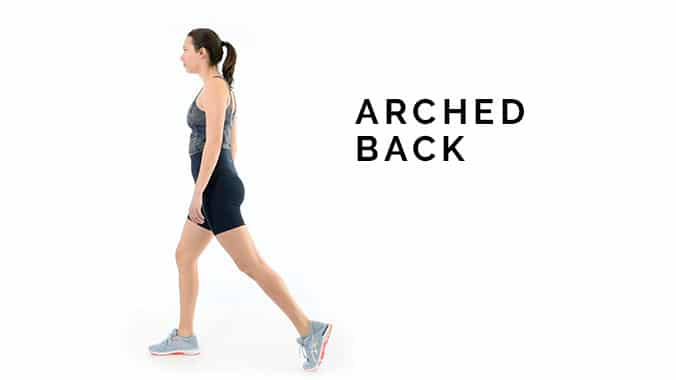
An arched back or bilateral rib flare inhibits the leg muscles and shifts the load onto the knees and spine. A strong arch can also lead to butt wink in the split squat.
To fix it:
- Take a breath in and sigh out all of the air, letting the shoulders slouch slightly
- Pause for 5 seconds at the end of the exhale
- Continue breathing as normal while maintaining this position
I prefer to fix this one at the top of the split squat, but the arch might return when descending to the bottom of the lift. In this case, move slowly and resist the urge to arch the back.
Lacking hip drive
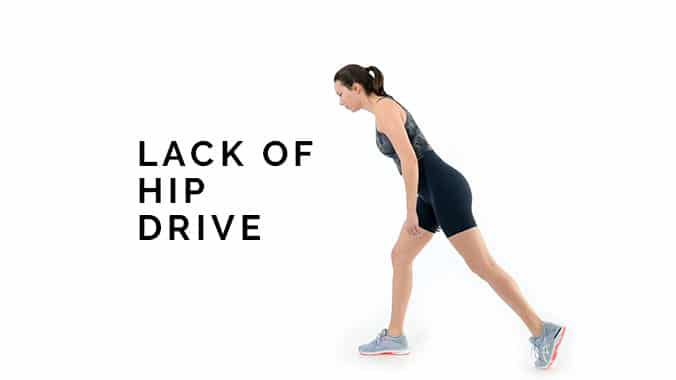
A lack of hip drive in the split squat shifts the load onto the low back. This is common in lifters who feel a tight low back after doing split squats.
To fix it:
- Start at the bottom of the split squat and slowly push through the entire front foot
- While rising, cue the butt forward, attempting to feel the exercise in the legs and glutes
A lack of hip drive is obvious when the lifter bends over. The knee locks out too quickly and the torso never stands up tall.
Don’t rush! Moving slowly really helps feel the technique.
Front heel rise
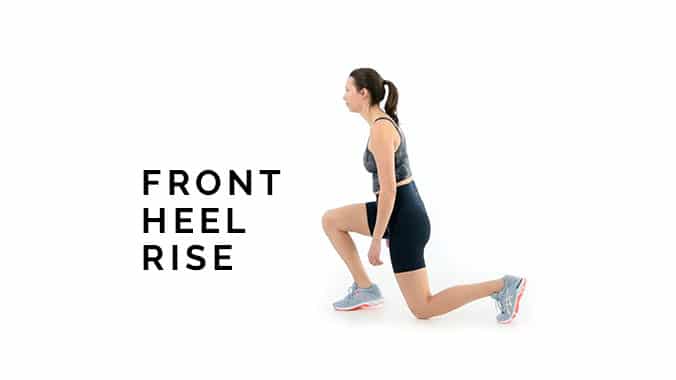
Front heel rise means the joints above the feet are misaligned. Pushing through the toes places more shear stress on the knee, which is particularly bad for those who’ve had prior knee issues such as ACL or meniscus tears.
It will also kick on the hip flexors, which limits hip mobility and can cause a “pinching” pain in the hip.
To fix it:
- Keep the front foot flat
That’s really it. Just put the heel into the ground and keep it there. Slowing down and reducing the weight can help.
Fixing foot position totally changes muscle activity above. Driving through the heel activates the glutes, hamstrings, and quads while reducing strain on the knees, hips, and spine.
A lifter is usually WEAKER when making this change because they now have to use muscles that they don’t normally use. This might require slowing down and lessening the weight.
In cases where the lifter is not using any external load, the body’s weight may be too heavy for the legs to control. Assist with support like a chair or squat rack in these cases.
Hunched over
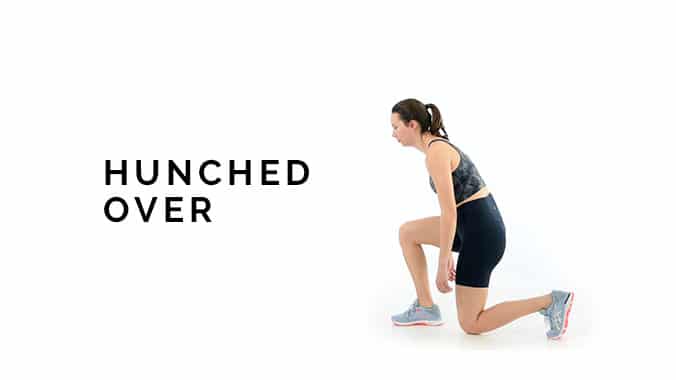
Hunching over can place undesired stress on the spine, especially done when with heavy loads.
To fix it:
- Stay tall from the trailing knee to the top of the head throughout the lift
This fix is easier to conceptualize than it is to perform. Aim to “feel it” in the legs; more burning sensation is better.
This cue can cause problems when taken to the extreme. Avoid arching the back.
Bowing over
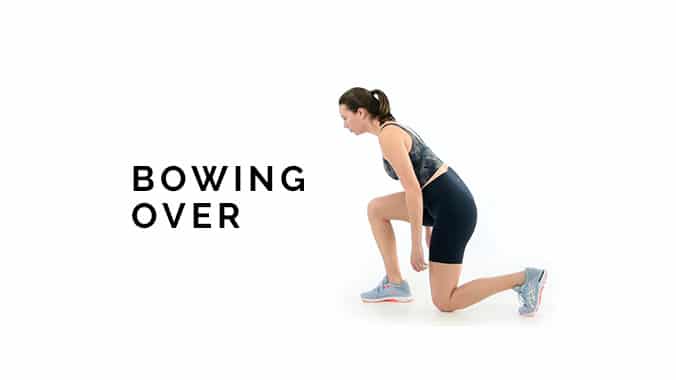
Bowing over is an indication that the hip bones are poorly aligned. The lifter bows over to avoid using the quads and hamstrings, making the movement more hip-dominant.
To fix it:
- Take a breath in and sigh out all of the air, tucking the hips with a posterior pelvic tilt
- Keep the front foot flat while allowing the front knee to come forward slightly
- Make the torso more upright to put it in line with the trailing thigh at the bottom of the split squat
Pushing the knee over the toes can increase shear forces through the knee, increasing wear and tear. It’s important to drive through the heel throughout the split squat.
The hamstrings are generally too long in lifters who bow over on their split squats. It may help to imagine a towel underneath the front foot while attempting to scoot the front foot backward as if pulling the towel toward the body. The foot should not actually move, but attempting this helps activate the hamstrings.
Front knee alignment
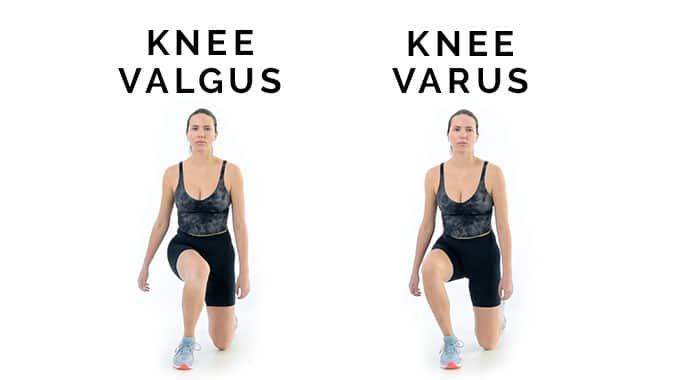
Knee valgus and knee varus are bad for knee health.
Knee valgus is when the knee is inside the line made by the hip and ankle. This is more common in newer lifters.
Knee varus is when the knee is outside the line made by the hip and ankle. This is more common is more experienced lifters.
To fix it:
- Start at the bottom of the split squat and adjust the front knee so that it is in line with the hip and ankle
Aligning the knee changes the pressure through the foot. When fixing knee valgus, the lifter feels more of the outer foot and often more glute activity as well. When fixing knee varus, the lifter feels more of the arch of the foot and often more quad activity.
Trailing knee alignment
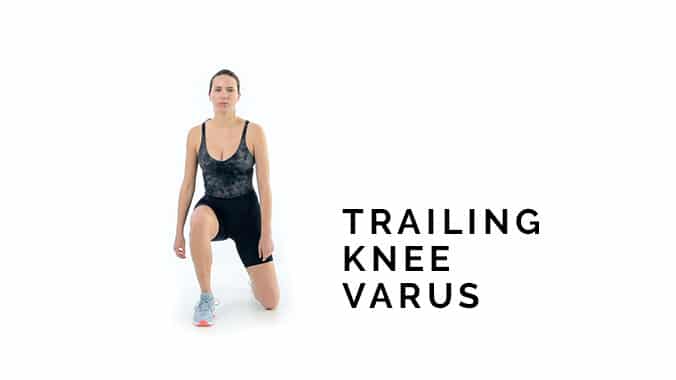
Knee valgus and knee varus are also important in the trailing knee. Knee varus is much more common in the trailing leg and it’s because of tight hip flexors.
To fix it:
- Start at the top of the split squat, take a big exhale, and tuck the hips into a posterior pelvic tilt
- Maintain the hip tuck while descending, attempting to feel a quad stretch on the trailing leg
The rectus femoris is a quad muscle that doubles as a hip flexor. It gets stretched very long at the bottom of the split squat, but also participates in raising up the lifter. It has passive tension from stretching and active tension from muscle activity. This is why this muscle often feels tight in the split squat.
One lesser known function of the rectus femoris is hip external rotation. When this muscle receives too much tension, our inclination is to lessen the stretch by letting the knee turn out. This is the mechanism of knee varus in the trailing leg and demonstrates why it’s important to feel the quad stretch during the movement.
Limiting range of motion at the bottom may also help.
Hip sagging
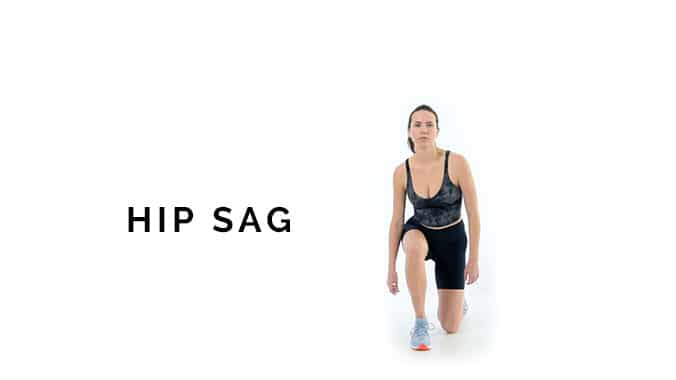
Hip sagging in the split squat predicts hip shifting the squat. This is more commonly seen on the right hip, but could be present on the left side as well.
We can attribute hip sagging to a long, weak gluteus medius. This is commonly referred to as a “Trendelenburg sign” or “Trendelenburg gait” due to the sagging of the hip when walking in patients with superior gluteal nerve damage.
To fix it:
- Start at the top of the split squat and push hard through the arch of the front foot
- Hike the opposite hip up toward the shoulder
- Maintain this position throughout the lift
This cue is hardest to maintain at the bottom of the movement. It helps to reduce the load and range of motion.
The hip should have a slight sag at the bottom of the split squat, tilting the pelvis away from the front leg. Too much tilt, however, is too much.
The trick is to know how much is normal and how much is excessive. Since the right hip usually sags more than the left, I recommend watching how both sides perform the split squat, and then trying to get the right leg to look like the left.
Hips not squared forward
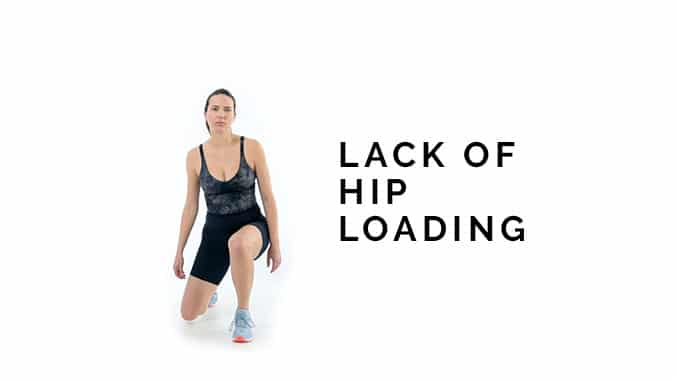
Hip alignment is the centerpiece of good technique. If the front hip is lacking mobility, the lifter will be unable to load the muscles throughout the split squat and will instead resort to placing undue stress on the joints and ligaments.
This lack of loading is more common on the left hip, but could be present on the right side as well.
To fix it:
- Start at the top of the split squat and flatten the front foot
- Rotate the hips so that the trailing hip comes forward and the front hip comes backward
- Hike the front hip up toward the shoulder
- Attempt to feel strong outer glute activity throughout the movement
If the lifter has trouble with this cue, they may benefit from additional posterior hip capsule inhibition.
Bad hip alignment often coincides with an asymmetrical rib flare.
Asymmetrical rib flare
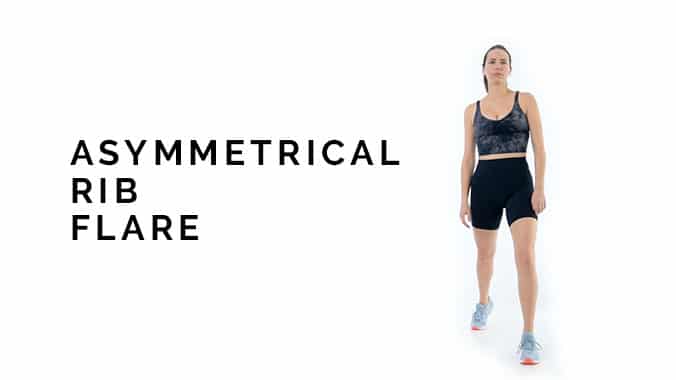
An asymmetrical rib flare suggests the spine is twisted.
A twist is actually normal in some respects during the split squat as it helps us load the leg muscles effectively while maintaining balance.
The rib flare, however, is undesirable. It’s more common on the left side, but can be seen on the right side as well.
To fix it:
- Start at the top of the split squat, take a big exhale, tuck the hips into a posterior pelvic tilt, and tuck the ribs down toward the hips
- Rotate the shoulders toward the rib flare until it disappears
- Maintain this position throughout the lift
An asymmetrical rib flare likes to resurface when the lifter inhales. Make sure the breathe easily when attempting to fix this.
When holding weights, it is okay to keep the shoulders turned throughout the lift.
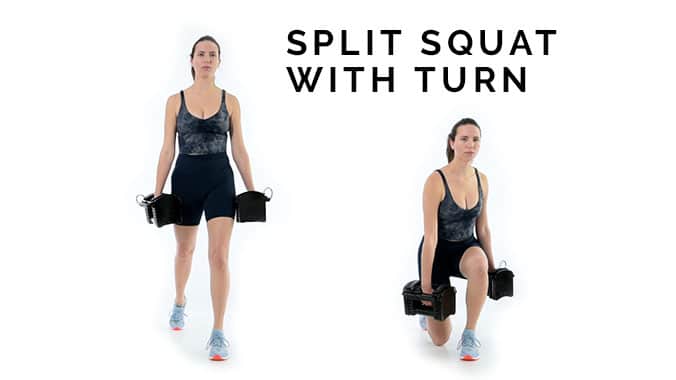
When in doubt, rotate too much. The goal is not to have both sets of lower ribs pointed forward, but to have them pointing toward the front leg.
This cue may become easier when combined with the hip loading cues in the previous section.
Knee pain during the split squat
Medical Disclaimer
Exercise is not without risk, even for healthy individuals. Same goes for diet. Make sure your doctor is okay with your self-experimentation. By visiting and remaining on this website, you acknowledge and agree that you have been assessed by a qualified medical professional who has given you consent to take part in physical activity.
Both the front and trailing knees can experience discomfort during the split squat.
If there’s pain in the front knee
- Keep the front foot flat (see above)
- Make sure the knee is in line with the hip and ankle (see above)
- Make sure hips are squared forward (see above) and not sagging (see above)
If there’s pain in the trailing knee
- Shift more weight onto the front foot while pushing less through the trailing foot
- Ensure the hips stay tucked while descending, aiming to feel a quad stretch at the bottom (see above)
If these cues do not solve the issue, it might be worth adding in a hamstring activation or hip flexor inhibition exercise. For a ton of those, see my 11 Best Alternatives to Quad Stretches.
If those exercises don’t provide relief, you should see your doctor and potentially a physical therapist.
Back pain during the split squat
Back pain generally indicates too much low back muscle activity, a lack of experience with the movement, or a twist through the low back.
If there’s pain in the back
- Remind the lifter to stay tall throughout the movement (see above)
- Attempt to make the legs burn as much as possible during the set by driving the hips forward on the way up (see above)
- Keep the front knee in line with the hip and ankle (see above)
- Square the hips forward throughout the lift (see above)
If this doesn’t provide enough relief, consider an alternative exercise like the Rear Foot-Elevated Split Squat.
If the back pain sticks around, make sure to talk to your doctor about it.
Toe pain during the split squat
Toe pain is shockingly disruptive. A lot of sensation comes from that little joint.
We can generally attribute toe discomfort to a lack of mobility. The toe should have 80 degrees of extension, which is plenty for split squats. This mobility is limited when the calf and foot muscles are persistently activated, like when the hips are misaligned.
If there’s pain in the toe
- Shift more weight onto the front foot while pushing less through the trailing foot
- Ensure the hips stay tucked while descending, aiming to feel a quad stretch at the bottom (see above)
- Add in some calf inhibition exercises to your warm up like the Plank to Downward Dog or Bear Walk
If this doesn’t provide enough relief, consider an alternative exercise like the Rear Foot-Elevated Split Squat.
If the toe pain sticks around, make sure to talk to your doctor about it.
Hip pain during the split squat
Hip pain can result from a muscle activity imbalance or general anatomical limitations. The hips will generally have a “pinching”, restricted feeling in the front near the hip flexors.
If there’s pain in the hip
- Keep the front foot flat (see above)
- Drive the hips forward on ascent (see above) and limit bowing over at the bottom (see above)
- Make sure the knee is in line with the hip and ankle (see above)
- Square the hips forward (see above) and limit hip sagging (see above)
If these cues do not solve the issue, it might be worth adding in a hamstring activation or hip flexor inhibition exercise. For a ton of those, see my 11 Best Alternatives to Quad Stretches.
If those exercises don’t provide relief, you should see your doctor and potentially a physical therapist. You may have some anatomical limitations that will be difficult to work around.
Summary
Split squats are a VERY useful exercise. They are complicated, however, and easy to mess up. I include some variation of them in (probably) every program I write.
And I think you should, too.
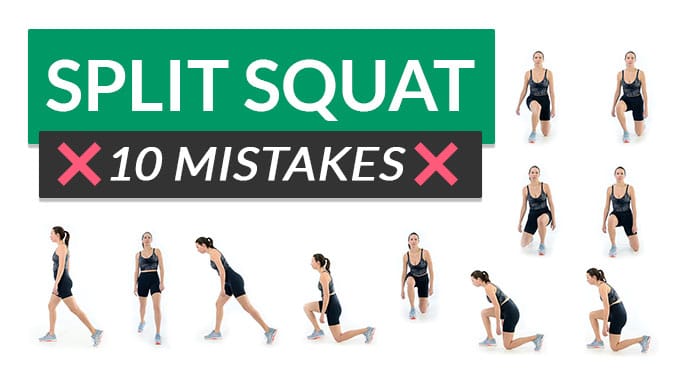

Add some color to this commentary.